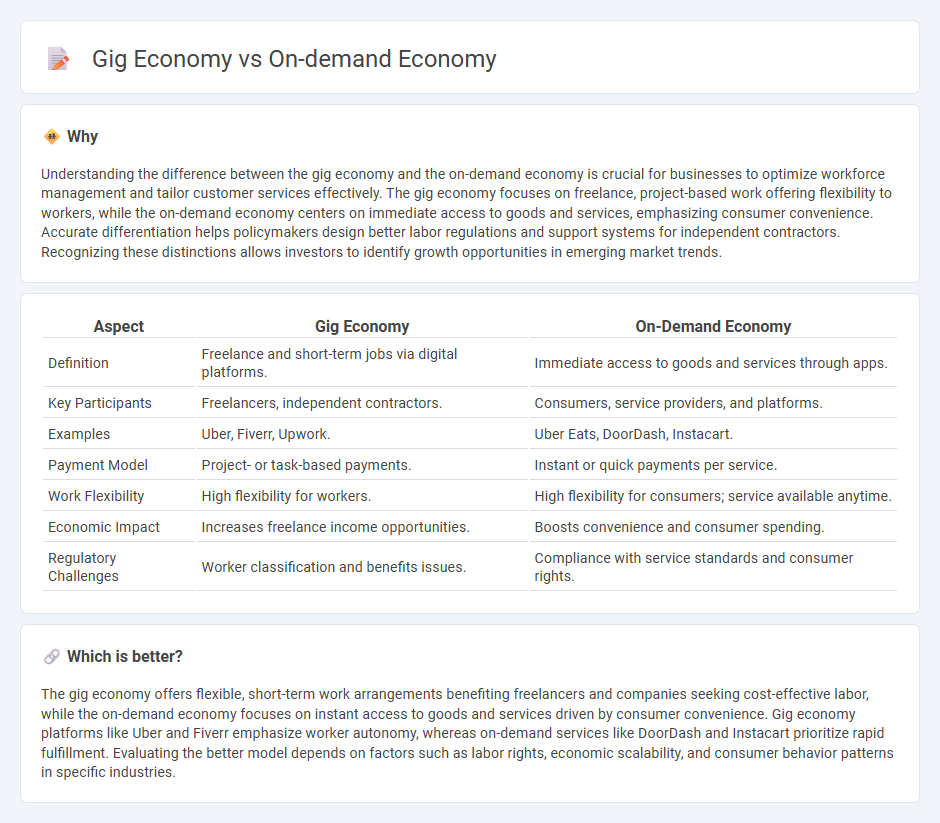
The gig economy centers on short-term, freelance work where individuals complete tasks independently, often through digital platforms like Uber or Fiverr. The on-demand economy focuses on immediate access to goods and services, driven by consumer demand and facilitated by apps such as DoorDash and Instacart. Explore how these economic models are reshaping labor markets and consumer behavior.
Why it is important
Understanding the difference between the gig economy and the on-demand economy is crucial for businesses to optimize workforce management and tailor customer services effectively. The gig economy focuses on freelance, project-based work offering flexibility to workers, while the on-demand economy centers on immediate access to goods and services, emphasizing consumer convenience. Accurate differentiation helps policymakers design better labor regulations and support systems for independent contractors. Recognizing these distinctions allows investors to identify growth opportunities in emerging market trends.
Comparison Table
| Aspect | Gig Economy | On-Demand Economy |
|---|---|---|
| Definition | Freelance and short-term jobs via digital platforms. | Immediate access to goods and services through apps. |
| Key Participants | Freelancers, independent contractors. | Consumers, service providers, and platforms. |
| Examples | Uber, Fiverr, Upwork. | Uber Eats, DoorDash, Instacart. |
| Payment Model | Project- or task-based payments. | Instant or quick payments per service. |
| Work Flexibility | High flexibility for workers. | High flexibility for consumers; service available anytime. |
| Economic Impact | Increases freelance income opportunities. | Boosts convenience and consumer spending. |
| Regulatory Challenges | Worker classification and benefits issues. | Compliance with service standards and consumer rights. |
Which is better?
The gig economy offers flexible, short-term work arrangements benefiting freelancers and companies seeking cost-effective labor, while the on-demand economy focuses on instant access to goods and services driven by consumer convenience. Gig economy platforms like Uber and Fiverr emphasize worker autonomy, whereas on-demand services like DoorDash and Instacart prioritize rapid fulfillment. Evaluating the better model depends on factors such as labor rights, economic scalability, and consumer behavior patterns in specific industries.
Connection
The gig economy and on-demand economy are interconnected through their reliance on digital platforms that facilitate flexible, short-term work arrangements and immediate access to goods and services. Both economies leverage technology to match supply and demand efficiently, enabling workers to offer skills or products on a task-by-task basis while consumers benefit from rapid, convenient service delivery. This synergy drives economic flexibility, amplifies job opportunities, and transforms traditional labor markets by emphasizing service immediacy and workforce adaptability.
Key Terms
Flexibility
The on-demand economy emphasizes immediate access to goods and services, offering unparalleled flexibility for consumers seeking instant solutions. The gig economy centers on flexible work arrangements, empowering freelancers to choose when and how they work, often without long-term commitments. Discover more about how these economies reshape modern flexibility and impact daily life.
Independent Contractors
The on-demand economy relies heavily on independent contractors who provide services through digital platforms, enabling rapid consumer access to goods and services. In contrast, the gig economy encompasses a broader range of freelance activities, often involving project-based or temporary work beyond app-driven tasks. Explore how these economic models shape the future of independent contracting and workforce flexibility.
Platform-based Services
Platform-based services in the on-demand economy provide immediate access to goods and services through digital platforms, emphasizing convenience and speed for consumers. The gig economy centers on freelance or temporary work facilitated by these platforms, where workers engage in flexible, short-term jobs without traditional employment benefits. Explore further to understand how these platforms reshape workforce dynamics and consumer behavior.
Source and External Links
What is On-Demand Economy? Definition & Meaning - Ikajo Glossary - The on-demand economy is an economic model that connects service providers and consumers through digital platforms (websites or apps), enabling instant access to services like food delivery, transportation, and online tutoring, with payments and feedback handled within the platform.
The On-Demand Economy Is Growing, and Not Just for the Young and Wealthy - The on-demand economy encompasses a wide range of services--from online marketplaces and transportation to food delivery and home services--attracting millions of consumers and generating tens of billions in annual spending across diverse demographics.
The on-demand economy - The on-demand economy allows consumers to quickly access goods and services via web or mobile apps, offering convenience, real-time tracking, and personalized experiences, with transactions and reviews managed within the platform.
 dowidth.com
dowidth.com